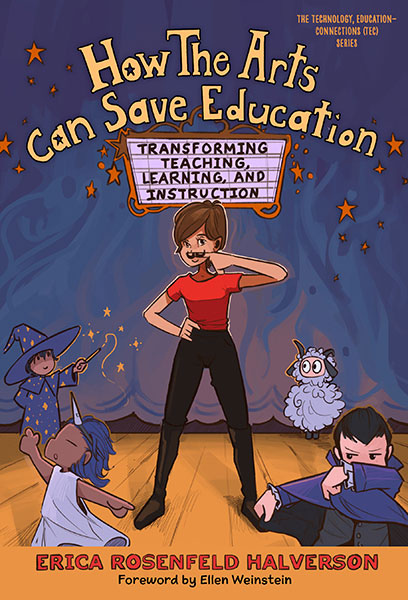Professors: Request an Exam Copy
Print copies available for US orders only. For orders outside the US, see our international distributors.
Foreword by: Ellen Weinstein
Publication Date: October 22, 2021
Pages: 168
Series: Technology, Education—Connections (The TEC Series)

This book provides a blueprint for using the arts—performing, visual, and multimedia—to rethink what good learning, teaching, and curriculum can be. The author presents a bold plan for saving education with an arts-based approach to teaching that focuses on risk-taking as the most important aspect of a successful classroom. Halverson offers new models for learning that embrace the social, cultural, and historical assets that kids bring to the classroom, with guidance for designing engaging learning experiences for all grades and subject areas. Featuring many evocative examples from Whoopensocker, the author’s in-school artist-in-residence program, this resource illustrates how classroom practices and school structures can be reorganized for more inclusive success. Readers will learn how to reframe learning as acts of metacognitive representation, identity, and collaboration. And lots and lots of joy.
Book Features:
Erica Rosenfeld Halverson is a professor in the Department of Curriculum and Instruction at the University of Wisconsin–Madison. In 2020, she received the Chancellor’s Distinguished Teaching Award. Visit Erica’s website at ericahalverson.com.
“Halverson blends insightful scholarship with humorous narrative to make a convincing case for the importance of the arts in education. This book speaks directly and inspiringly to teachers and teacher educators about creative, necessary classroom practices with today’s youth.”
—Johnny Saldaña, professor emeritus, Arizona State University
“A must-read for all educators…Erica shines a light on the impact and transformative power of high-quality arts experiences in the life of young learners and reflects on what happens in the moment when students are engaged at the highest level, when they are given real-world reasons for working hard. It is a focus on deep learning that transfers to everything that follows in the life of a student.”
—From the Foreword by Ellen Weinstein, artistic director, National Dance Institute
Contents
Foreword Ellen Weinstein ix
Acknowledgments xi
Introduction: Something Extraordinary of Its Kind 1
We Built This City … on Educational Research 3
Learning In and Through the Arts 4
Improv as the Model for Good Teaching 5
Reimagining Curriculum Through the Lens of Design 7
The Arts Take Center Stage 8
Taking the Arts to School 9
1. Whoop It Up! Sock It to Me! 11
Whoopensocker (n.): Something Extraordinary of Its Kind 12
Telling Stories, Adapting Stories, and Performing Stories 14
Telling Stories 17
Adapting Stories 24
Performing Stories 25
“The Joe” 26
2. We Built This City … On Educational Research 30
A Place for Cognitive Science (and Cognitive Science in Its Place) 30
The New Literacies 35
Culturally Relevant and Sustaining Pedagogies 40
Bringing Cognitive Science, the New Literacies, and Asset Pedagogies Together Through the Arts 43
3. Learning in and Through the Arts 46
An Argument in Favor of Transforming Learning 46
How Can the Arts Reshape Learning? 48
Representations + Identity + Collaboration = Learning! 66
4. Improvisation as the Model for Good Teaching 68
What Is Improv? 69
Improv Is Good Teaching 70
What Does Teaching-as-Improv Look Like? 77
What Do We Do Now? 83
5. Reimagining Curriculum Through the Lens of Design 84
Why Talk About Design? 85
Three Things! 88
From Curriculum to Design 99
6. The Arts Take Center Stage 100
Act I: The Accountability Machine 101
Act II: The Rise of STEM 104
Act III: Putting the Arts at the Center 110
7. Taking the Arts to School 113
Big Idea 1: Honor Risk-Taking as an Essential Feature of Teaching and Learning 113
Big Idea 2: Embrace Identity and Representation as Core Ideas, but Do Not Mistake One for the Other 119
Big Idea 3: Taking Collective Responsibility 125
Every Idea Is a Good Idea 129
Notes 130
References 133
Index 141
About the Author 151
Professors: Request an Exam Copy
Print copies available for US orders only. For orders outside the US, see our international distributors.